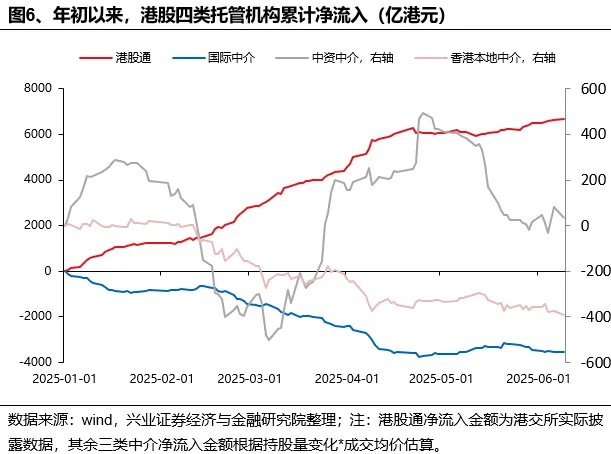
What is the recent structure of capital inflow in the Hong Kong stock market?

近期港股資金流入主要由南下資金推動,4 月 8 日至 6 月 9 日港股通淨流入 1514.5 億港元,全年累計超 6600 億港元。國際中介資金持續流出,主要加倉方向為軟件服務、藥品、生物科技、汽車等,減持金融和能源板塊。南下資金在個股上加倉美團、建設銀行、阿里巴巴等,減持騰訊、小米等。
根據港股託管機構拆分來看,南下資金是近期也是今年以來推動港股行情的主力資金。4 月 8 日至 6 月 9 日,港股通累計淨流入 1514.5 億港元,而同期國際中介、中資中介和香港本地中介分別減倉 847.2 億港元、180.4 億港元、84.2 億港元。全年來看,截至6月 9日,港股通累計已淨流入超 6600億港元,遠超其他三類託管機構。


而從國際中介的視角來看,近兩個月中外資或延續了年初至今的流出趨勢。一方面,對沖基金或於 4 月底至 5 月中階段性有所回流,但持續低位的 Hibor 利率驅動靈活資金以套息交易的方式轉為加倉美元資產。另一方面,根據 EPFR 數據,以海外主動權益基金為代表的長線資金依然延續流出。


行業層面上,互聯網、汽車、新消費和創新藥是近期資金加倉的主要方向,而金融和能源等紅利板塊遭減持較多。根據測算,4 月 8 日至 6 月 9 日,資金主要加倉軟件服務、藥品及生物科技、汽車、專業零售(阿里巴巴 + 美團)和工業工程等板塊,淨流出銀行、其他金融、石油及天然氣、保險和一般金屬及礦石等行業較多。
分機構類型來看:
-
南下資金淨流入創新藥、專業零售、電訊、銀行和石油及天然氣等板塊,減持軟件服務和資訊科技器材較多;
-
國際中介青睞軟件服務和資訊科技器材,顯著減倉銀行、創新藥和專業零售;
-
中資中介和香港本地中介主要加倉專業零售、資訊科技器材、汽車和半導體,淨流出紅利板塊較多。
值得注意的是,南下資港股通在軟件服務、資訊科技器材和紅利板塊上與其他類三類機構存在較大的分歧,僅在專業零售行業上與中資中介和香港本地中介形成共識。

個股層面上,從四類機構淨流入前十的個股來看:
南下資金延續 “啞鈴型” 配置思路。4 月 8 日-6 月 9 日,港股通主要加倉美團-W、建設銀行、阿里巴巴-W、中國銀行和招商銀行,淨流出騰訊控股、小米集團-W、中芯國際、中國財險和華潤啤酒較多。

外資顯著青睞具有特色商業模式的科技和消費企業,減持紅利板塊,醫藥內部有所分化。4 月 8 日-6 月 9 日,國際中介主要加倉騰訊控股、小米集團-W、珍酒李渡、香港交易所和小鵬汽車-W,淨流出美團-W、阿里巴巴-W、建設銀行、中國海洋石油和中國神華。

中資中介主要淨流入阿里巴巴等科技股,減倉金融行業較多。4 月 8 日-6 月 9 日,中資中介主要加倉阿里巴巴-W、聯想集團、美團-W、中芯國際和速騰聚創,淨流出中信證券、珍酒李渡、香港交易所、騰訊控股和滙豐控股。

香港本地中介同樣以加倉阿里巴巴等科技股並減倉金融行業為主。4 月 8 日-6 月 9 日,香港本地中介主要加倉阿里巴巴-W、比亞迪股份、中芯國際、京東集團-SW 和小米集團-W,淨流出香港交易所、滙豐控股、騰訊控股、農業銀行和中國移動。

本文作者:張啓堯,來源:堯望後市,原文標題:《【興證策略張啓堯團隊】近期港股資金流入結構如何?》

